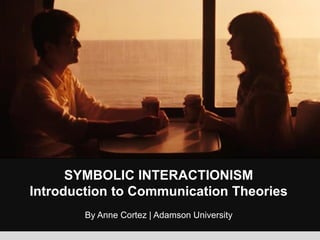Symbolic Interactionism by George Herbert Mead
- 1. SYMBOLIC INTERACTIONISM Introduction to Communication Theories By Anne Cortez | Adamson University
- 2. Discussion Outline •Interpersonal Communication •Symbolic Interaction •Creation of the Self •Summary
- 5. Our thoughts, self-concept, and the wider community we live in are created through communication—symbolic interaction. -George Herbert Mead
- 6. George Herbert Mead was an influential philosophy professor at the University of Chicago, but he never published his ideas. After his death, his students published his teachings in Mind, Self, and Society.
- 7. We find ourselves NOT through introspection, but through interaction with other people.
- 8. SYMBOLIC INTERACTION- The ongoing use of language and gestures in anticipation of how the other will react; a conversation.
- 10. Communication is the most human and humanizing activity in which people are engaged. -Herbert Blumer Herbert Blumer - Mead’s chief disciple- coined the term symbolic interactionism.
- 11. SYMBOLIC INTERACTIONISM THINKING LANGUAGE MEANING
- 12. SYMBOLIC INTERACTIONISM Premise 1: Humans act toward people or things on the basis of the meanings they assign to those people or things
- 13. art terror prof
- 14. SYMBOL- a stimulus that has a learned meaning and value for people
- 15. Reality is a social construction. (Berger & Luckmann, 1996)
- 16. Principles of Early Economic Systems •Reciprocity •Redistribution •Householding SOCIAL CONSTRUCTION SHARED MEANING The communal creation of the social world in which we live. People’s common interpretation or mutual understanding of what a verbal or nonverbal message signifies.
- 17. “All the world’s a stage, and all the men and women merely players.”
- 18. What is reality?
- 19. SYMBOLIC INTERACTIONISM Premise 2: Meaning arises out of the social interaction that people have with each other; meaning is negotiated through language
- 20. Words are symbols. Words do not have inherent meaning. We assign meaning to words.
- 21. SOCIAL CONSTRUCTION STIMULUS INTERPRETATION RESPONSE Meaning Making Process
- 22. The words that we use have default assumptions.
- 24. SYMBOLIC INTERACTIONISM Premise 3: An individual’s interpretation of symbols is modified by his or her own thought processes
- 26. Thinking is an inner conversation. Mead called this inner dialogue minding.
- 27. Taking the role of the other- the process of mentally imagining that you are someone else who is viewing you
- 28. “You never really know a man until you stand in his shoes and walk around in them.”
- 29. The SELF is the joining point between the individual and the society. Communication is the link that allows the intersection to occur.
- 30. THE SELF: I and Me I - the spontaneous, driving force that fosters all that is novel, unpredictable, and unorganized in the self Me - the objective self; the image of self seen when one takes the role of the other
- 31. Looking-glass self The mental self-image that results from taking the role of the other; the objective self; me.
- 32. We are born with no sense of self. Self arises in interaction with others.
- 33. Generalized other- the composite mental image a person has of his or her self based on societal expectations and responses
- 34. SYMBOLIC INTERACTIONISM •Humans act toward people or things on the basis of the meanings they assign to those people or things •Meaning arises out of the social interaction that people have with each other; meaning is negotiated through language •An individual’s interpretation of symbols is modified by his or her own thought processes
- 35. Our thoughts, self-concept, and the wider community we live in are created through communication—symbolic interaction. We use language and meaning making to create the self and the reality.
- 36. REFERENCES Em Griffin, A First Look at Communication Theory, 2006. Stephen Littlejohn and Karen Foss, Communication Theory, 2010.
- 37. QUESTIONS?





































